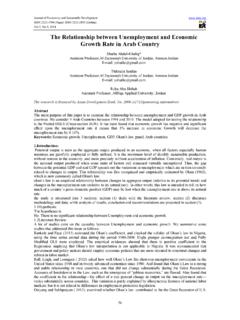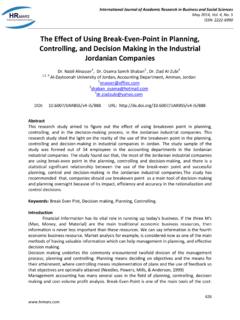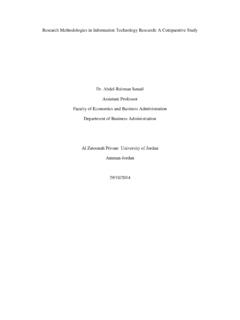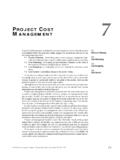Transcription of Quantity Surveying Class Notes - Al-Zaytoonah …
1 I Al-Zaytoonah Private University of Jordan Faculty of Engineering/Civil Engineering Department CE 902573 Specifications and Quantity Surveying - 3 credits Quantity Surveying Class Notes By Dr. Hesham Ahmad First Edition I Table of Contents Table of Contents ..I Chapter 1: Introduction .. 1 Definition of Quantity Survey .. 1 Data Required for the Preparation of an Estimate or Quantity Survey .. 1 Importance of Quantity Survey .. 2 Types of Estimates and Quantity Survey .. 2 Contracts .. 3 Obligations of the employer ( ) .. 3 Obligations of the Contractor ( ) .. 3 Role of the Engineer ( ) .. 4 Types of Contracts.
2 5 Measured or Unit rate Contract .. 5 Lumpsum contract .. 6 Cost-plus contract .. 6 Construction Management Contract ( ) .. 7 Chapter 2: Quantity Survey Items and Methods .. 8 Introduction .. 8 Bill of quantities BOQ ( ) .. 9 Excavation ( ) .. 10 Swell and Compaction .. 10 Cross-section Method (Grid Method) .. 11 Cut and Fill with Paving .. 19 Simple Grid Method .. 20 General Excavation .. 21 Basement Excavation .. 21 Continuous Footing Excavation .. 23 Spread Footing Excavation .. 24 Backfilling ( ) .. 25 Backfilling the Basement Walls .. 25 Backfilling the Continuous Foundations .. 26 Concrete Works ( ).
3 28 Jordanian Specifications .. 28 Examples .. 29 Blinding ( ) .. 30 Concrete of Footings ( ) .. 31 Concrete of Slabs( ) .. 33 Steel Reinforcement( ) .. 35 Plastering ( ) .. 39 Bricks ( ) .. 42 Masonry Work ( ) .. 46 1 Chapter 1: Introduction Definition of Quantity Survey Quantity survey is a schedule of quantities of all the items of work in a building. Data Required for the Preparation of an Estimate or Quantity Survey Drawings Complete and fully dimensioned drawings ( plans, elevations, sections and other details) of the building or work in question are required.
4 Specifications Detailed specifications, giving the nature, quality and Class of work, materials to be used, quality of the material, their proportions, and method of preparation are required. Rates The rates of various of work, materials to be used in the construction, wages of different categories of labor (skilled or unskilled) and cost of transportation charges should be available for preparing an estimate of work cost. Actual Finished Work quantities can be calculated from the actual work done in the project site. - The quantities mainly can be calculated as: Quantity = Length Width (Height or Thickness), Quantity = Area of cross-section Length, Quantity = Length Width, Quantity = Length.
5 Quantity = Number of Units. Quantity = Weight. 2 Importance of Quantity Survey 1. Quantity survey is essential to estimate before the construction starts the probable cost of construction for the complete work. The construction cost includes cost of materials, cost of transportation, cost of labor, cost of scaffolding, cost of tools and plants, establishment and supervision charges, cost of water, taxes and reasonable profit of the contractor, etc. The estimate is required in inviting tenders for the works and to arrange contract for a complete project. 2. Quantity survey is required to estimate the quantities of the various materials required and the labor involved for satisfactory completion of a construction project.
6 3. It is also useful to check the works done by contractors during and after the execution. Also the payment to the contractor is done according to the actual measurements of the completed part of each item of work. 4. A complete Quantity survey or estimate is useful to provide useful advice to clients on: (i) Valuation of properties (land and building) for sale, purchase and mortgage etc. (ii) Fixation of standard rent. (iii) For insurance and claim for damages in a building. (iv) For the process of resolving disputes by referring to a third party. Types of Estimates and Quantity Survey Preliminary or Approximate Estimate This is to find out an approximate cost in a short time.
7 It is used to give an idea of the cost of a proposed project. This estimate helps the client or sanctioning authority to make decision of the administrative approval. The approximate cost is prepared from the comparison with similar works. The approximate cost can be found by using methods that depends on the area or cubic content of a building and then multiplying this by an estimated rate for the unit of the area or cubic content. Approximate quantities of materials and labor required per m2 of the area for a proposed building also can be found. Detailed Estimate After getting the administrative approval, this estimate is prepared in detail prior to inviting of tenders.
8 The whole project is divided into sub-works, and the quantities of each sub-work are calculated separately. The dimensions of the required work are taken from the drawings of the project. Quantity Estimates This is a complete estimate of quantities for all items during project implementation. Revised Estimate Prepared if the estimate exceeded by 5% due to the rates being found insufficient or due to some other reason. Maintenance Estimate 3 estimating required quantities and cost of work to maintain a structure (road, building, etc.) Contracts Contract is an agreement between two or more parties creating obligations ( ) that are enforceable or recognizable at law ( ) It establishes an obligation of each party ( , ) to fulfill what it is agreed to perform.
9 Obligations of the employer ( ) 1. Appointing of the engineer to administer the contract 2. Provision of the site 3. Provision of information, permits, and approvals 4. Providing funds and making payments in accordance with the contract 5. Participation in consultations with the engineer to agree matters on claims or conflicts between parties. Obligations of the Contractor ( ) 1. Execution and completion of the works and remedying ( ) any defects ( ) therein. 2. Provision of ( :): a. Labor, materials, plant, and equipment needed b. Preparation of progress report c. Works program for execution, and updating it whenever required d.
10 Setting out of the works e. Measurement and/or assisting the engineer to do so f. Records of his personnel and equipment g. Sample of materials specified h. Testing and re-testing i. Temporary works j. Facilities for other contractors working on the site k. Keeping the site clean, and remove rubbish 3. The contractor is required to: a. Sign the contract when he is called to do so b. Obtain and submit securities, guarantees, and insurance policies c. Ensure that his representatives will be available on site at all times 4 d. Prepare and submit the contractor s document, including as built drawings and manuals of operation and maintenance e. Attend to the engineer s instructions f.













